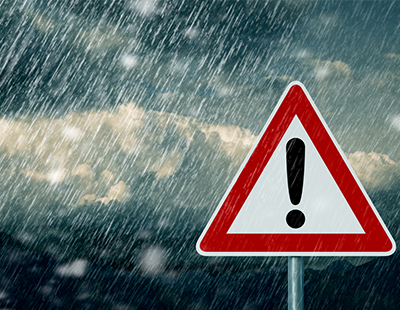Heavy snowfall can present a number of dangers to your property.
Gutters can become clogged or even frozen due to snow and ice, which can lead to unsightly damage if they overflow or burst. Excessive snowfall left on the roof can place undue stress on the structure, which could collapse in extreme circumstances.
Remember that if your roof’s pitch is especially steep, it’s less likely to suffer beneath snow unless conditions are particularly extreme. If you have an older property, or your home features flat roofs, it may be more urgent for you to remove snow from the roof in good time.
There are multiple ways to check your roof has too much snow on it, such as:
- Sagging ceiling boards: A ceiling sagging under the pressure of weight above is a sure sign your roof is carrying more than it can handle. If the boards, beams, or any other part of your ceiling appear to be drooping, it’s a warning that something is wrong. Outside of heavy snow fall, this could indicate the beams are old and need replacing, or that they’re suffering from rot.
- Strange noises: If you hear strange noises coming from above, particularly creaking, this could mean that the beams and rafters in your roof space are under excessive pressure, and may be starting to get damaged. If these areas of your roof are visible in the loft, it’s absolutely vital to check their condition. Pay close attention and look out for cracks or other obvious signs of wear.
- Cracks in the walls and roof: A roof doesn’t collapse all at once, and many of the warning signs won’t just be apparent in your roof space. If you begin to see cracks and crevices appearing in your walls, then the structure above is suffering under excess weight, and it may be time to act and remove snow from your roof.
- Roof leaks: Another clear sign that you need to take action is a leaking roof. A roof covered with too much snow will become warped and cracked, allowing snow to drift into interior components of your roof space. As the snow melts, it can leak into the spaces below.
- Doors and windows: Are your doors and windows not shutting into their frames properly, or are you perhaps struggling to open them? Whilst this is more commonly due to the cold weather, it could be a sign that the frames have become warped, excessively strained by the weight on snow on the roof above.
If you want to remove the snow yourself, instead of calling a professional, here are some tips:
1. The best way to get rid of snow on your roof is with a snow rake, which can be used to drag snow off the roof from ground level – far safer than working at height;
2. If you don’t have a snow rake, do not use metal tools, as these can damage roofing materials;
3. Work your way down from the roof ridge (the highest point), leaving a few inches of snow instead of scraping your roof clean to minimise the risk of damage;
4. Be careful where you move the snow, do not drop any in front of doorways, and don’t pile snow anywhere on the roof, even if you’re going to remove it later;
5. Lastly, only remove snow from your roof when it’s safe for you to do so. You always have the option to call a professional, or simply wait for the snow to melt.
*Gian-Carlo Grossi is managing director of Roofing Megastore and more snow tips can be found here
We're excited to announce that we're working on building a shiny new website for readers of Landlord Today! As part of this process, commenting on articles will be temporarily disabled. We look forward to sharing our new and improved Landlord Today website with you shortly!







.png)

(1).png)




